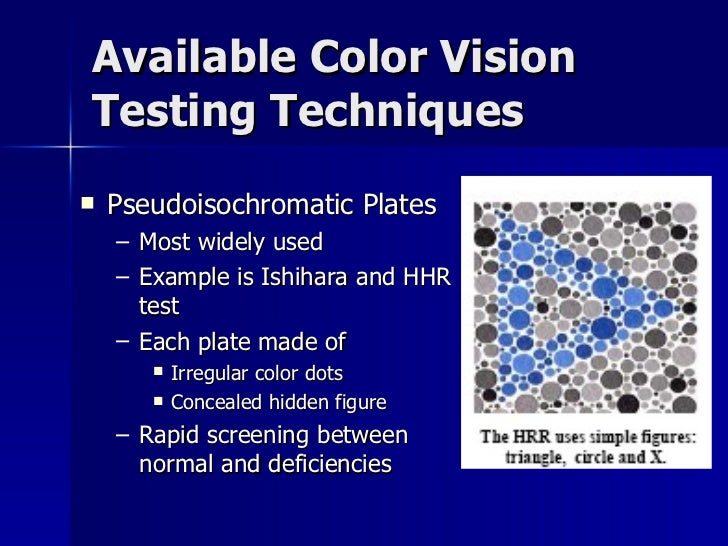Aoc Hrr 2nd Edition Test
▸ ▸ ▸ ▸ ▸ ▸ ▸ ▸ Guide for Aviation Medical Examiners • • • • Decision Considerations Aerospace Medical Dispositions Item 52. Color Vision TESTS APPROVED FOR AIRMEN ARE NOT ALL ACCEPTABLE FOR AIR TRAFFIC CONTROLLERS (FAA employee 2152 series and contract tower air traffic controllers). FOR ATCS INFORMATION, see the ( PDF) chart or contact your for any questions. The following criteria apply to AIRMEN ONLY: An applicant meets the color vision standard if he/she passes any of the color vision tests listed in. If an applicant fails any of these tests, inform the applicant of the option of taking any of the other acceptable color vision tests listed in Item 52. Color Vision Examination Equipment and Techniques before requesting the Specialized Operational Medical Tests in Section D below.
Inform the applicant that if he/she takes and fails any component of the ( PDF) in Section D, then he/she will not be permitted to take any of the remaining listed office-based color vision tests in Examination Techniques, Item 52. Color Vision as an attempt to remove any color vision limits or restrictions on their airman medical certificate. That pathway is no longer an option to the airman, and no new result will be considered. An applicant does not meet the color vision standard if testing reveals: A. All Classes • AOC (1965 edition) pseudoisochromatic plates: seven or more errors on plates 1-15.
• AOC-HRR (second edition): Any error in test plates 7-11. Because the first 4 plates in the test book are for demonstration only, test plate 7 is actually the eleventh plate in the book. (See instruction booklet.) • Dvorine pseudoisochromatic plates (second edition, 15 plates): seven or more errors on plates 1-15. • Ishihara pseudoisochromatic plates: Concise 14-plate edition: six or more errors on plates 1-11; the 24-plate edition: seven or more errors on plates 1-15; the 38-plate edition: nine or more errors on plates 1-21.
Aug 5, 2014 - Dvorine pseudo-isochromatic plates is an approved test for color. Ishihara, Dvorine, AOC-HRR, Richmond 1983-edition, 15 plates.
• Richmond (1983 edition) pseudoisochromatic plates: seven or more errors on plates 1-15. • OPTEC 900 Vision tester and Farnsworth Lantern test: an average of more than one error per series of nine color pairs in series 2 and 3. (See instruction booklet.) • Titmus Vision Tester, Titmus i400, OPTEC 2000 Vision Tester, Keystone Orthoscope, or Keystone View Telebinocular: any errors in the six plates. • Richmond-HRR, 4th edition: two or more errors on plates 5-24. Plates 1-4 are for demonstration only; plates 5-10 are screening plates; and plates 11-24 are diagnostic plates. Certificate Limitation If an applicant fails to meet the color vision standard as interpreted above but is otherwise qualified, the Examiner must issue a medical certificate bearing the limitation: NOT VALID FOR NIGHT FLYING OR BY COLOR SIGNAL CONTROL C.
The color vision screening tests above (Section A) are not to be used for the purpose of removing color vision limits/restrictions from medical certificates of airmen who have failed the Specialized Operational Medical Tests below (Section D). See bold paragraph in the introduction of this section (above). Specialized Operational Medical Tests for Applicants Who Do Not Meet the Standard.
Torrent crack anno 1701 serial. Applicants who fail the color vision screening test as listed, but desire an airman medical certificate without the color vision limitation, may be given, upon request, an opportunity to take and pass additional operational color perception tests. If the airman passes the operational color vision perception test(s), then he/she will be issued a Letter of Evidence (LOE). • The operational tests are determined by the class of medical certificate requested.
The request should be in writing and directed to AMCD or RFS. See NOTE for description of the operational color perception tests. • Applicants for a third-class medical certificate need only take the Operational Color Vision Test (OCVT).
• The applicant is permitted to take the OCVT only once during the day. If the applicant fails, he/she may request to take the OCVT at night.
If the applicant elects to take the OCVT at night, he/she may take it only once. • For an upgrade to first- or second-class medical certificate, the applicant must first pass the OCVT during daylight and then pass the color vision Medical Flight Test (MFT). If the applicant fails the OCVT during the day, he/she will not be allowed to apply for an upgrade to First- or Second-Class certificate. If the applicant fails the color vision MFT, he/she is not permitted to upgrade to first- or second-class certificate. An LOE may restrict an applicant to a third-class medical certificate.
Airmen shall not be issued a medical certificate of higher class than indicated on the LOE. Exercise care in reviewing an LOE before issuing a medical certificate to an airman.
